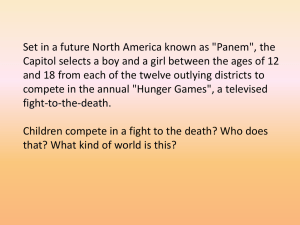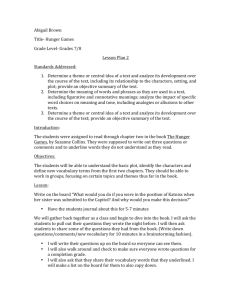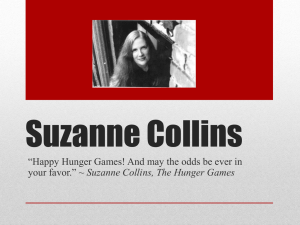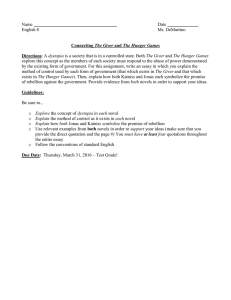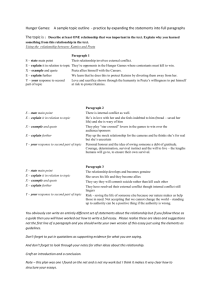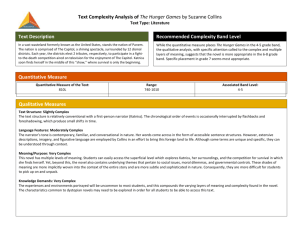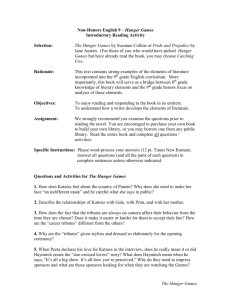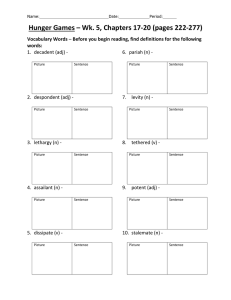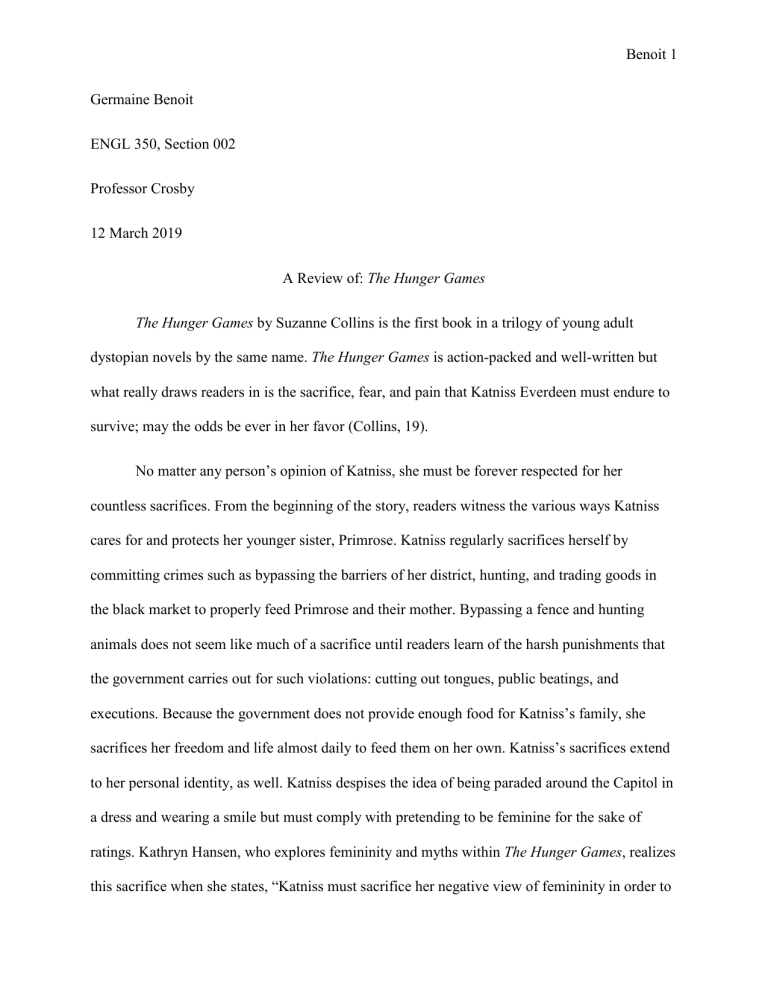
Benoit 1 Germaine Benoit ENGL 350, Section 002 Professor Crosby 12 March 2019 A Review of: The Hunger Games The Hunger Games by Suzanne Collins is the first book in a trilogy of young adult dystopian novels by the same name. The Hunger Games is action-packed and well-written but what really draws readers in is the sacrifice, fear, and pain that Katniss Everdeen must endure to survive; may the odds be ever in her favor (Collins, 19). No matter any person’s opinion of Katniss, she must be forever respected for her countless sacrifices. From the beginning of the story, readers witness the various ways Katniss cares for and protects her younger sister, Primrose. Katniss regularly sacrifices herself by committing crimes such as bypassing the barriers of her district, hunting, and trading goods in the black market to properly feed Primrose and their mother. Bypassing a fence and hunting animals does not seem like much of a sacrifice until readers learn of the harsh punishments that the government carries out for such violations: cutting out tongues, public beatings, and executions. Because the government does not provide enough food for Katniss’s family, she sacrifices her freedom and life almost daily to feed them on her own. Katniss’s sacrifices extend to her personal identity, as well. Katniss despises the idea of being paraded around the Capitol in a dress and wearing a smile but must comply with pretending to be feminine for the sake of ratings. Kathryn Hansen, who explores femininity and myths within The Hunger Games, realizes this sacrifice when she states, “Katniss must sacrifice her negative view of femininity in order to Benoit 2 break away from the repressions of selfhood enforced by the Capitol” (175). Katniss’s biggest sacrifice, however, is herself. Readers finally see how far Katniss is willing to go to protect her younger sister when she shocks her district and volunteers to replace her sister, Primrose, as tribute to compete in The Hunger Games. It is in these games that only one person out of twentyfour people will survive. Katniss explains everyone’s shock at her gesture when she states, “In District 12, where the word tribute is pretty much synonymous with the word corpse, volunteers are all but extinct” (22). This is a bittersweet moment and the ultimate sacrifice as readers realize that to protect Primrose, Katniss must be separated from her –possibly forever. Fear plays a major role in The Hunger Games as death is constantly lurking around the corner. It leaps off the page and latches onto readers, forcing us to imagine a world where our own government controls every move that we make, and we go all in –rooting for Katniss to prevail. Author Suzanne Collins speculates about readers’ personal fears in an interview with TIME’s Lev Grossman when she states: “I think people respond to dystopian stories because they’re ways of acting out anxieties that we have and fears that we have about the future.” The harsh punishments handed out for committing the smallest of crimes serve to put fear into citizens that cripple them from even having thoughts of revolting. While Katniss seems to make fearless decisions, she only does so because she can’t bear the alternatives. Katniss is filled with fear but still does things like sneaks out to hunt because she can’t bear to watch her family starve and volunteers as tribute because she can’t bear to watch her sister fight to her death. Brilliantly, the presence of so much fear in The Hunger Games does not equate to an absence of bravery; this keeps young adults turning the pages, seemingly unable or unwilling to put the novel down. Katniss endures untold amounts pain in The Hunger Games, both physically and emotionally. The first real pain readers become aware of is hunger. In fact, Katniss’s fellow Benoit 3 tribute, Peeta, once endured a beating by his mother just to give her a burned loaf of bread to help her starving family. Suzanne Collins explains in an interview with James Blasingame that hunger is simply a tactic used by the Capital for control: “The sociopolitical overtones of The Hunger Games were very intentionally created to characterize current and past world events, including the use of hunger as a weapon to control populations” (726). As if the emotional pain of being ripped from the only home you’ve ever known, being barely allowed to say goodbye to your family, and knowing you will most likely be killed in the comings days is not enough, the people controlling the game use many tactics to inflict physical pain on the tributes, as well. Over the course of time spent in the arena, game controllers release a wild fire that burns Katniss’s hands and legs, release Tracker Jackers that sting the tributes and make them hallucinate and replay painful memories, and release “mutts” that are sent to chase and kill the last group of surviving tributes. The pain being inflicted on citizens by the government is not limited to the tributes competing for survival. While it is obvious that the game controllers are sadistic, The Hunger Games makes it abundantly clear that they are inflicting additional pain on the tributes for broadcasting purposes. While Katniss is running from the flames and being stung by Tracker Jackers, her family and best friend are forced to watch it all happening live and there is absolutely nothing that any of them can do to help. Overall, The Hunger Games details the ugliest of situations to highlight the most beautiful relationships. A sister, a neighbor, or a best friend –all are worth the pain, sacrifice, and fear that Katniss Everdeen bravely endures just to survive. Benoit 4 Works Cited Blasingame, James, and Suzanne Collins. “An Interview with Suzanne Collins.” Journal of Adolescent & Adult Literacy, vol. 52, no. 8, 2009, pp. 726–727. JSTOR, www.jstor.org/stable/27654337. Collins, Suzanne. The Hunger Games. Scholastic Press, 2008. Print. Grossman, Lev. “Come for the Love Story, Stay for the War”: A Conversation with Suzanne Collins and Francis Lawrence. TIME. 22 Nov 2013. http://entertainment.time.com/2013/11/22/come-for-the-love-story-stay-for-the-war-aconversation-with-suzanne-collins-and-francis-lawrence/ Hansen, Kathryn Strong. "The Metamorphosis of Katniss Everdeen: The Hunger Games, Myth, and Femininity." Children's Literature Association Quarterly, vol. 40 no. 2, 2015, pp. 161-178. Project MUSE, doi:10.1353/chq.2015.0020
